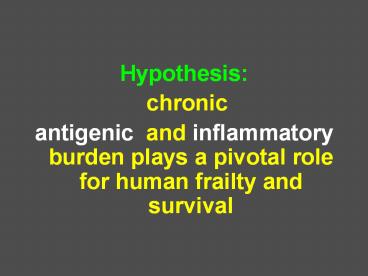Hypothesis: PowerPoint PPT Presentation
1 / 36
Title: Hypothesis:
1
- Hypothesis
- chronic
- antigenic and inflammatory burden plays a
pivotal role for human frailty and survival
2
- old people have to cope with a lifelong
antigenic burden encompassing several decades of
evolutionary unpredicted antigenic exposure
3
INFLAMM-AGING
Optimal remodeling (hormesis) Low proinflammatory
status High efficiency of stress response
Inadequate remodeling High proinflammatory
status Low efficiency of stress response
AGE
Remodelling / Stress response
Inflammatory response
Effects of stress
4
INFLAMM-AGING
- IL-6
5
Genotype-sex interaction
Serum IL-6
C- Males
C- Females
C Females
C - males have higher serum IL-6 in respect to
age-matched C males and C/C- females
C Males
Age
30
60
90
6
(No Transcript)
7
- IL-10
8
Inflamm-aging
- IL-10
- IL-10 is a major immunoregulatory cytokine
which inhibits activation and effector function
of T cells, monocytes and macrophages, and its
principal routine function appears to limit and
ultimately terminate inflammatory responses
9
MALES
Il
-
10 "Functional Genotype"
Il
-
10 high
Il
-
10 Low
production
production
Controls (89)
27
73
N
24
65
Centenarians (65)
44,6
55,4
N
29
36
Pearson Chi
-
square test 5.184 df1
p0.026
10
- IL-6 and IGF1
11
INSULIN/IGF-1 SIGNALING PATHWAY HUMAN HOMOLOGIES
WITH NEMATODE, FLIES AND MICE
MOUSE
NEMATODE
FLY
Insulin/IGF-1
Ligand
Ligand
GH
INS/IGF1 R
INR b
INR
DAF-2
GHR (-/-)
Chico
IRS1-2
?
p85/p110a-b
Dp110/p60
AGE 1
?
Forkhead transcription factor
DAF-16
GLUCOSE METABOLISM
DEVELOPMENT
LONGEVITY
12
Am. J. Physiol. Endocrinol. Metab. 284
E481-E487, 2003
13
(No Transcript)
14
Table 2. Correlations between IL-6, IL-6
receptor and IGF-1 and anthropometric and
physical performance parameters (n526)
IL-6
IL-6 receptor
IGF-1
p
p
p
Age
0.36
lt.001
0.16
lt.001
-0.25
lt.001
BMI
0.14
lt.003
-0.04
NS
-0.23
lt.001
-0.17
lt.001
-0.03
NS
0.14
lt.05
Handgrip
-0.14
lt.005
-0.05
NS
0.15
lt.001
Total power
Back log trasformed
15
(No Transcript)
16
(No Transcript)
17
(No Transcript)
18
(No Transcript)
19
(No Transcript)
20
(No Transcript)
21
POLYMORPHISMS OF THE IGF-1 RESPONSE PATHWAY GENES
AFFECT HUMAN LONGEVITY AND IGF-I PLASMA LEVELS
CUES FOR AN EVOLUTIONARY-CONSERVED MECHANISM OF
LIFE-SPAN CONTROL Bonafè M , Barbieri M ,
Marchegiani F , Olivieri F, Ragno E ,
Giampieri C , Mugianesi E , Centurelli
O, Franceschi C and Paolisso G
Department of Experimental Pathology-Universit
y of Bologna via S. Giacomo 12, 40126-Bologna,
Italy Department of Geriatricof Geriatric
Medicine and Metabolic Diseases - II University
of Naples Piazza Miraglia 2, 80138- Naples,
Italy Italian National Research Centers on
Aging (INRCA), via Birarelli 8, 60100 -Ancona,
Italy Journal of Clinical Endocrinology and
Metabolism, July 2003 in press
22
EXPERIMENTAL APPROACH
WE INVESTIGATED the role of genetic variability
at human loci which share similarities (human
horthologs) with the genes which regulate the
insulin/IGF-I response in C. elegans and D.
melanogaster. namely IGF-1R (34 protein
sequence identity with C. elegans DAF-2) PIK3CB
(27 protein sequence identity with C.elegans
AGE-1) IRS-1 (30 protein sequence identity with
D. melanogaster CHICO) FOXO1A (49 protein
sequence identity with C. elegans DAF-16)
23
POLYMORPHISMS STUDIED
- IGF-1R Gene
- 3174, Codon 1013, Exon 16, G/A
- PI3K CB Gene
- -359 T/C
- 303 A/G
- IRS-1 Gene
- Codon 972, Exon1, G/A
- FOXO1A Gene
- 97347, Intron 1, T/C
24
SUBJECTS
Total N 496 Total N 496
AGED PEOPLE N278 Mean Age 54.821.5 ?76 ?202 CENTENARIANS N218 Mean Age 98.0 4.31 ?56 ?162
All subjects were neither diabetics nor
affected by impaired fasting glucose No subject
used drugs affecting insulin levels.
25
26
(No Transcript)
27
(No Transcript)
28
Simple correlation analysis between age and IGF-1
plasma levels in all study population (n 496)
29
Plasma free IGF-1 levels among different
genotypes independently of age and gender.
Variation of the group means plt0.05
30
RESULTS
a) in the whole population polymorphisms at
IGF-1R and PI3CKB loci are associated with
significant changes in plasma IGF-1 levels b)
individuals bearing at least one allele A at
IGF-1R locus (IGF-1R A) are found at an
increased proportion in long lived individuals
and have lower free plasma IGF-I levels than A-,
subjects c) Moreover, we found that genotype
combination of an A allele at IGF-1R locus and a
T allele at PI3CKB locus (A/T subjects) is
significantly increased in long lived individuals
whilst A-/T- individuals have the highest free
IGF-I plasma levels and show a trend to decrease
among the long-lived people.
31
Collectively, these data suggest that genetic
VARIANTS OF IGF-1R and PI3CKB GENES involved in
the intracellular IGF-I signaling pathway ()
jointly AFFECT two phenotypes IGF-I PLASMA
LEVELS AND LONGEVITY
32
The highest national life expectancy observed for
female, 1580 - present
Max Plank Institute for Demography, Rostock,
Germany, Annual Report 2001
33
- Antigenic Burden (AB) has a major impact on
survival and frailty - AB depends on
- historical period where you live
- geography (poor/dirty or rich/hygienized
countries) - - social/economic status and education
34
- Parameters offering a direct or indirect
measure of the lifelong antigenic load are
available - They give us a synthetic measure of the
lifelong attrition that each individual has
undergone as a consequence of both his lifestyle
and behaviour and its genetic tendency to develop
and inflammatory phenotype.
35
- To our knowledge such markers (number of CD8
memory or virgin T cells, expanded clones of
memory/regulatory T cells, telomere length in
peripheral blood lymphocytes, IL-6 plasma levels
and genotype IGF1 plasma levels IGF-1R
genotype) are the most powerful predictors of
frailty and mortality in the elderly actually
available - To this list TNFa, IL-10 and ApoE genotype and
mtDNA haplogroups and mutations must be added
36
(No Transcript)

